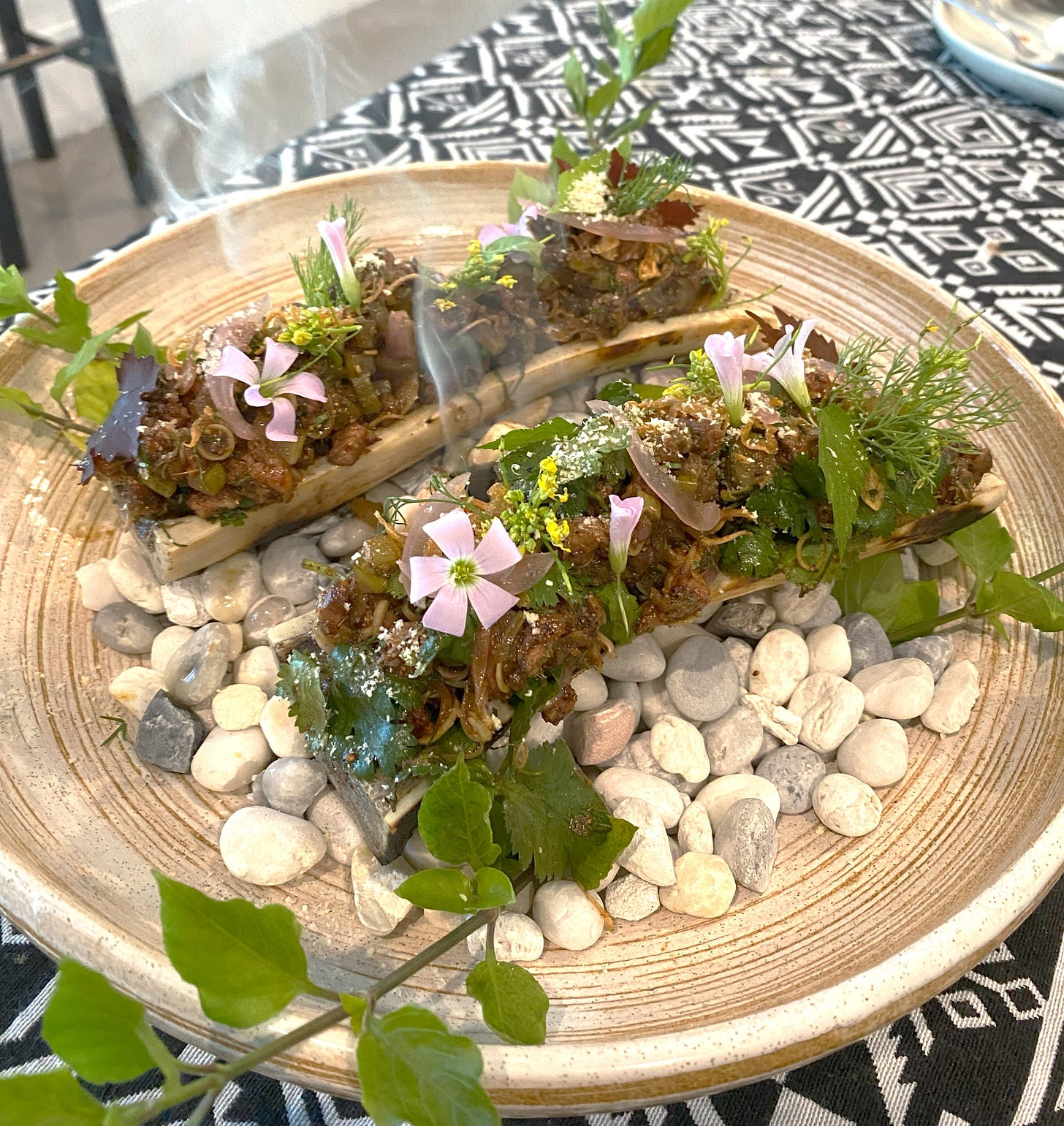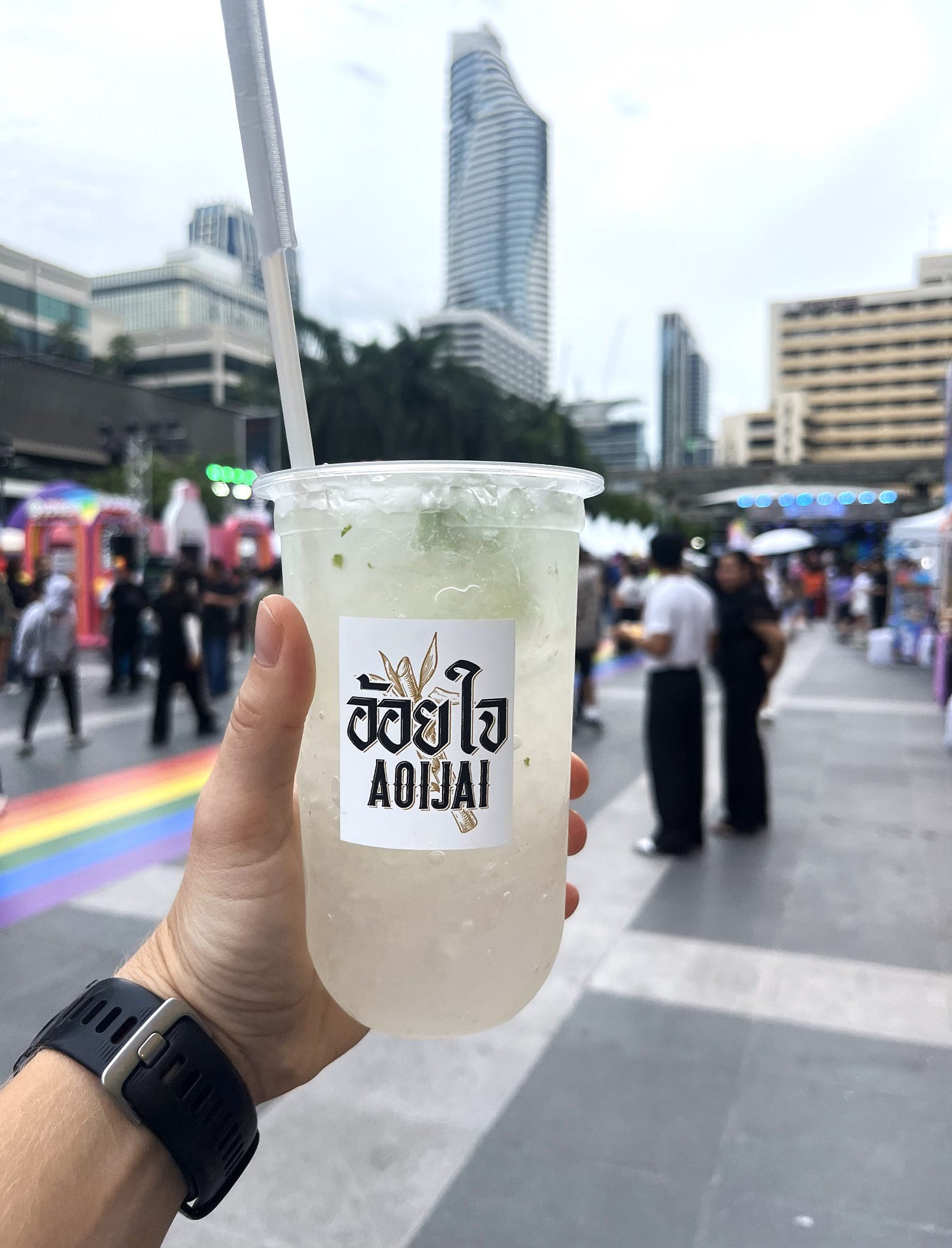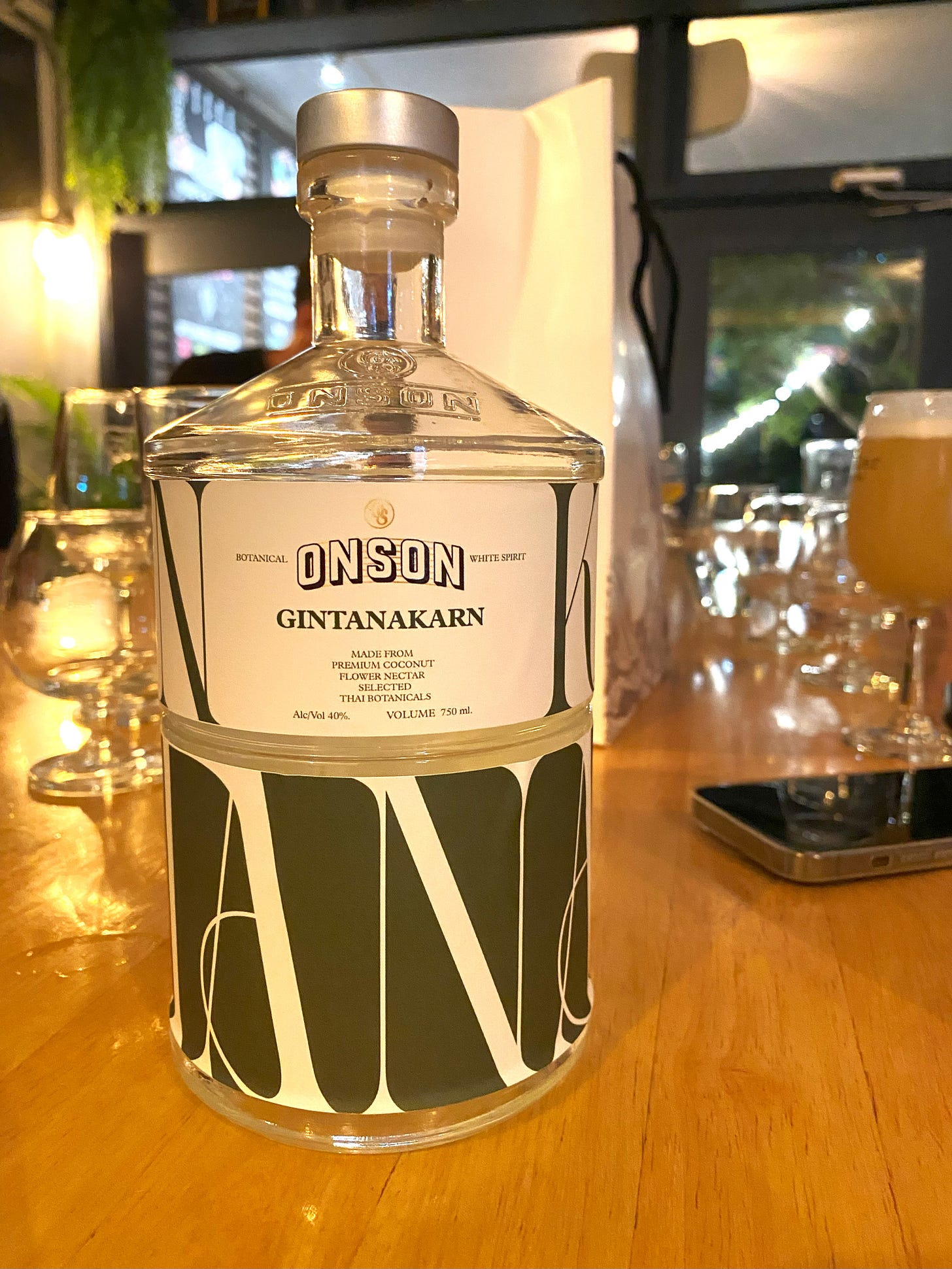Discovering the spirit behind Thai spirits
What Onson has taught me about Isaan, pride, and the Thai craft movement.
Onson at the distillery, a no-AC, fire-powered operation that is defying the odds.
Last October, on a whim, my wife and I went on a road trip across Isaan. It’s one of my favorite regions to visit in Thailand because there are no affectations. What you see is what you get and the people you meet as a traveler tend not to be inquisitive but rather welcoming regardless of the reason for your visit.
Such we experienced when we arrived at the Onson distillery unannounced.
Ever since Pita Limjaroenrat, former head of the Move Forward Party and a champion of the alcohol liberalization movement, named Onson one of his favorite Thai spirits, it had become impossible to get a bottle. At a Prachachon Beer event at Jatujak Market in August last year, lines for Onson sales stretched dozens deep, past the confines of the event and into the aisles of the market itself.
When we were mapping out our road trip, I pinned the distillery and figured it was a good enough excuse to visit a destination I knew almost nothing about. Now, I have a special affinity for the province, its people, and, of course, Onson.
A sample of the spirit of Isaan
I loved the hand-painted naga branding that wraps around the building.
Onson sits beside a highway on the outskirts of Sakhon Nakhon, the capital of the province of the same name. Not many travelers, domestic or international, visit here. As Tammawit “Tiger” Limlertcharoenwanich, founder of Onson, would tell me over coffee months later, Bangkok residents have historically associated Sakhon Nakhon with the dog meat trade. “For a long time, they called us ‘dog-eaters,’” he said.
The stereotype derives from labels slapped on the Catholic Vietnamese who immigrated to Sakhon Nakhon to escape religious persecution. It persists today.
International travelers, on the other hand, tend to skip Isaan in favor of known destinations like northern Thailand or the islands. The relative few who do visit the northeast rarely go to Sakhon Nakhon because it isn’t easy to reach. It’s closer to Hue in Vietnam, across the karst and jungles in the skinny part of Laos, than Bangkok.
All of which is to say: our visit was unusual. But it nearly didn’t happen.
We pulled up to Onson and found one other car in the parking lot. If you could call it a parking lot—it looked more like a loading zone. It was 4pm. According to Google, the distillery would close at 5pm. Of course, it had all of zero reviews on Google. Who knew if the operating hours were accurate, or if it was even open to drop-in visitors?
Apart from a hand-painted naga1 logo on the walls, Onson looked like a rice barn rather than the home base of one of Pita’s favorite spirits. But the doors were open, so we entered. Inside there were glass cases holding informational displays, some photos, and an award or two. The display cases were set up crooked, which made me think they were used only when officials or media groups were visiting.
Behind these display cases there was a still, and behind that five men were sitting in camping chairs beside large plastic containers. One noticed us, stood up, and shuffled over to the two visitors, looking potentially inquisitive and standing just inside his facility. He was wearing a white t-shirt and pha khao ma, a type of local sarong, wrapped around his waist.
His name was Tiger, this was his space, and he would be glad to show us around.
Distilling in Thailand is not easy
Over the next hour, Tiger walked us around the distillery2 and shared various Thai spirits with us. He was out of his Onson, a spirit made from all-natural, locally sourced coconut flower3, but whatever he had on hand we were free to try with him.
He gave us a good Thai white spirit4 made from sugarcane in Chaiyaphum as we talked about his work. Then we tried some rice-based lao khao and Sangvein, a rhum Agricole made in Suphan Buri. He had quite the collection on hand. He seemed to know everyone producing spirits legally, too.
Tiger never intended to be a distiller, he explained to me later. He simply loves his hometown and Isaan culture, and making spirits in and for Sakhon Nakhon was a natural manifestation of his affection for it.5
A few years earlier, he opened a restaurant called House Number 1712 to champion hyperlocal flavors and ingredients—local mushrooms and herbs like pak sa-ngae (ผักสะแงะ, mint), fish from Sakhon Nakhon’s Nong Han lake, the city’s famed pone yang kham beef, all reinterpreted into fine dining-caliber dishes. But he did not have a local spirit, wine, or beer to serve alongside the food, so he decided to make one himself.
Smoked, spiced tartare with bone marrow at House Number 1712. Terrible photo; excellent dish.
He had been refining his spirit and developing Onson into a legal entity for a couple of years by the time we visited. Yanking at my shirt in a vain attempt to dry the sweat on my chest, I told him I was surprised to find his distillery wasn’t air-conditioned.
“We’re limited to 50 horsepower,” Tiger told me. “Not enough for air-conditioning. We can’t even use electric power for our still. We have to do it with a wood fire.”
I wrote about the challenges of distilling in Thailand for PUNCH. If you want to understand the full extent of the obstacles aspiring distillers like Tiger must overcome, read that story.
If you want the condensed version, here it is:
While Thailand sort of liberalized distilling, it remains incredibly difficult to do it at a high level in Thailand. The big players are afforded such luxuries as climate control, electric and gas power, mass production, and as many employees as they want. (Distilleries like Onson can have just six.)
The rules sound absurd, I told Tiger. “It is hard,” he said, “but I won’t stop doing it.”
A rum, a gin, and a spirit that endures
Before the spirits blurred the depth of our conversation, Tiger mentioned he was also making a rhum Agricole, Aoi Jai, Isaan slang for “sweetheart.” He planned on making a gin, too.
Last week, at the Pride Festival outside CentralWorld in Bangkok, I noticed that Onson had set up a booth selling mojitos made with Aoi Jai. I was excited to see the gin was for sale, too.
The Aor Jai was grassy and left a rich coat on my tongue. Like so many craft Thai rums—Chalong Bay, Sangvein, Issan—it struck me as a great base for a mojito.6
An Aoi Jai mojito at Bangkok Pride. / Photo courtesy of Mrs. Critical Drinking.
The gin was called Gintanakarn—a play on a word that translates to “imagination.”7 It was made with Onson’s caramelized coconut flower spirit as the base and redolent with some clearly identifiable Thai botanicals, including the vanilla-like pandan leaf and white pepper. When you smell it, you know it’s Thai.
The more I’ve talked to Tiger over the past year, the plainer it is to see that making great spirits is only part of his mission. He loves his heritage and wants to shatter stereotypes about it. A core spirit made from slowly caramelized Thai coconut flower; a restaurant that has received coverage and acclaim from Thai media; branding, aromas, and flavors that transport you to Isaan—his pride is obvious.
Naturally, a bottle was purchased and then sampled at Mikkeller Bangkok.
What I’ve found most impressive is his dedication to this mission despite the roadblocks. When you’re up against forces beyond your control, jail time and fines included, the easy thing to do is quit. But he won’t quit because this isn’t about distilling. I find this is true of the entire Thai craft movement.
There’s a purpose beyond the products themselves. Even if the drinks are imperfect, the spirit driving the brewers, the distillers, and even the fans of them is enough to make you feel bullish about the future.
Sakhon Nakhon: go there
I’d be remiss if I didn’t mention how fantastic Sakhon Nakhon is to visit. The city is known for a few things: marbled pone yang kham beef, indigo, and the annual Christmas “star parade” that takes place in Tha Rae, the Catholic community on the north side of the lake. Like so much of Isaan today, however, there’s a vibrant new energy emanating from young, often Bangkok-educated entrepreneurs like Tiger.
Mann Craft sells boutique indigo clothing and décor; if you plan in advance, you can join indigo-making workshops at their rural outpost, Mann Gardens.
Nap’s is an excellent Ubon Ratchathani-based coffee roaster with branches across Isaan, including one near Sakhon Nakhon’s historic center, a street lined with dark wood houses and impressive temples.
As mentioned above, there are restaurants like House Number 1712. We ate there before leaving the city. It’s like the Samuay & Sons8 of Sakhon Nakhon, and it should satisfy anyone who likes to travel for culinary pleasure.
Pone Yang Kham shabu at Moong Yod.
Even outside of its Christmas festival, Tha Rae is great to visit. The buildings are different here, more like the French colonial architecture you find in Laos, and the food is influenced by Vietnamese traditions. It also, of course, has its own hip coffee shops, including local brand Guzzjung.
You can take boat tours of the manmade Nong Han Lake; hang out in the wonderful parks beside said lake; or hike in Phu Phan National Park. Up the road, there are Khmer ruins at Prasat Ku Phanna.
If you’re considering a visit, check out My Sakon Nakhon. It’s an indispensable resource.
The serpent so frequently seen in Southeast Asian Buddhist mythology.
It didn’t take long.
Being able to make about 1,000 bottles at a time doesn’t leave you with much to spare when people drop in to your distillery.
TL;DR: in Thailand, you can’t label a spirit for what it really is. It must be a “white” (lao khao) or “brown” (lao see) spirit. Chaiyaphum is a rum.
Among other things, he has played in a molam band and today officially promotes travel and culture in Isaan alongside Eve Palasak, founder of Zao, and others.
I have long believed that Thailand could be a rum-making powerhouse if small-scale distillers were given a fair crack at it. Sugarcane grows in abundance and ferments fast. The ingredients are there. The chefs just need a kitchen to cook. Expect a piece on this soon.
จินตนาการ; recall that you can’t call a gin a gin, so this is a cheeky play on words.
A highly regarded restaurant in Khon Kaen serving fine dining-caliber dishes made from hyperlocal, often foraged ingredients.









I just visited this place a few days back during our trip through Sakhon Nakhon and Nakhon Phanom. You hit the nail with this post, andit was a delight to read, especially after having visited the distillery. We got to taste all the types of liquor and then make it ourselves. What an experience!